The Rosen Outdoor Sculpture Competition & Exhibition is a national juried competition presented annually by the Turchin Center for the Visual Arts on the campus of Appalachian State University in Boone, North Carolina. The Rosen has become an integral part of An Appalachian Summer Festival, the university’s annual multi-arts celebration presented by the Office of Arts & Cultural Programs.
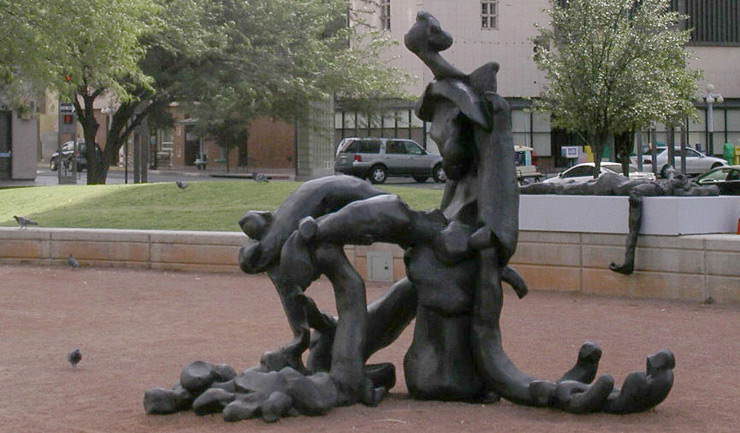
Curt Brill, Diana 41. 24th / 2010 Rosen Sculpture Competition Winner.
Sculptures
Diana 41
Curt Brill
Tuscon, Arizona
Bronze
8′ 6′ 1″ x 9′ 6″
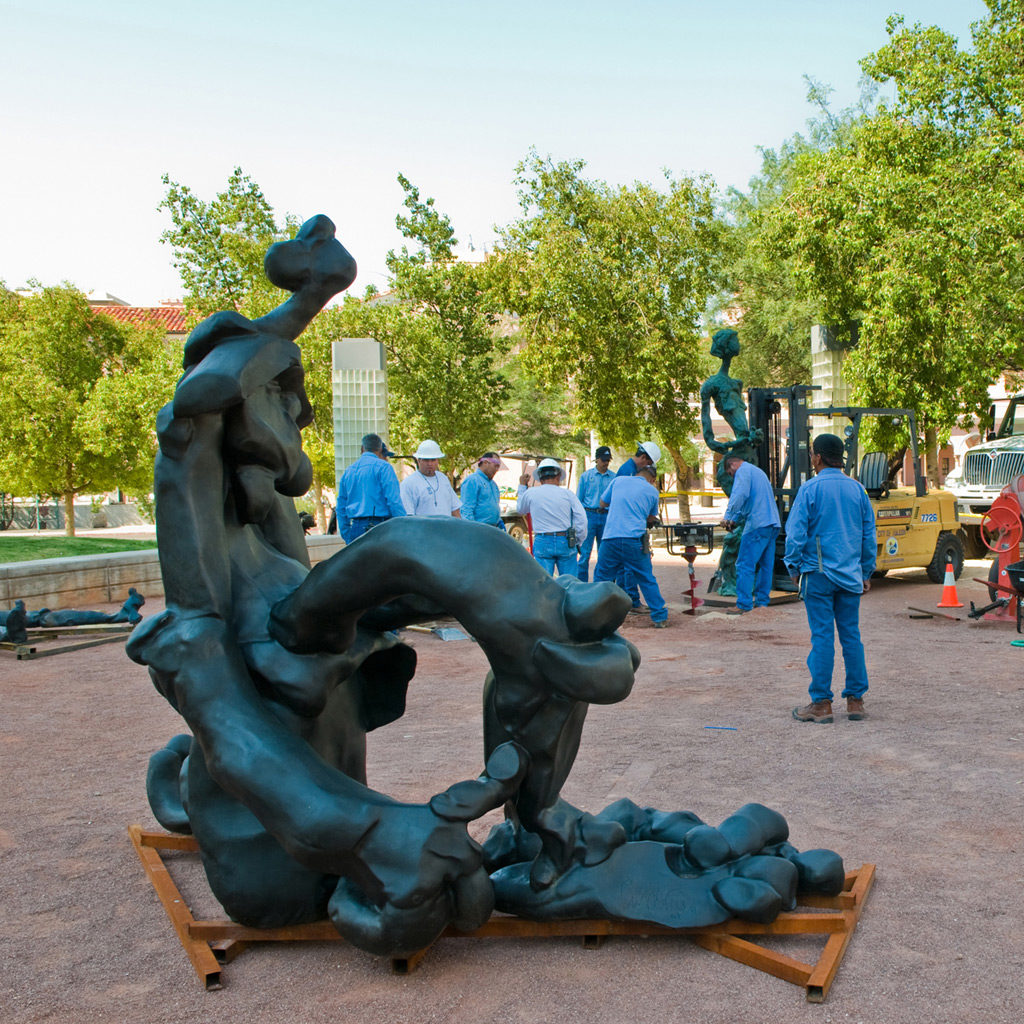
Artist statement
My search in the visual arts is for the hidden Human spirit. That small part that makes us each unique, yet finds us a common home. I have been a paid professional as well as an active volunteer in state run mental institutions, private and county run nursing homes and been a drug rehabilitation counselor. Overriding this vein is the love of movement and dance and the shear joy of a good laugh. These feelings find expression three – dimensionally in clay, plaster, wax and metal. In my pieces I first search for that bit of movement, then I search for the humor to help carry me through the piece, and in completion I search for serenity. My fortune lies in the knowledge that my audience has been like my work, ongoing.
About the artist
Born in 1952 in the Bronx, New York, Curt began his serious pursuit of an art career while attending Cornell University. It began with exhibitions at Cornell that showcased his drawings, ceramic work and silk screening. Even though drawing has been his first and enduring love, professionally he has been most noted for his 3 dimensional work. His ceramic pieces have been widely collected across the United States since the mid 1970’s. He began his career in bronze in 1980, with pieces that were a direct outgrowth of his history with clay. The work has always been sensual, a direct response to the feel of the materials he has chosen to use. Being a people watcher with a keen eye by nature, and having a potent sense of humor and an easy demeanor, it is easy to see how his personal style has evolved. His work has now been met with wide appeal by individual collectors within the United States, Europe and Japan.
For more information, visit www.curtbrill.com.
Anhinga
Harry McDaniel
Asheville, North Carolina
Aluminium
7′ 2″ x 4′ 6″ x 4′ 2″
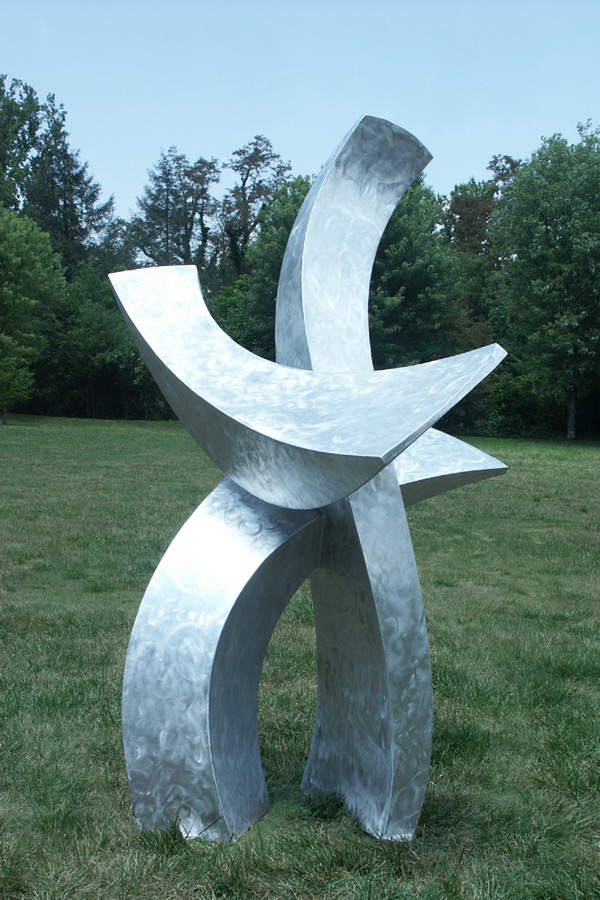
Artist statement
In designing Anhinga, I did not have any representational or conceptual intentions. I was simply working with forms in space to create a visual experience for the viewer. I wanted to elicit a feeling of motion and interaction between the three pieces. As you walk around the sculpture, you will find that there is really no front or back; the three pieces can be seen as a new composition from each viewing angle.
When I finished fabricating the sculpture, I saw birdlike qualities to the forms, so I searched through my bird book for inspiration for a title. I found it in the anhinga, a water bird that lives in a range from the southeastern U.S. to northern Argentina. The overall form of the sculpture does not look like an anhinga, but each piece suggests a part of the bird. With a bit of imagination, you can see the outstretched neck, the upward-lifted wings, and the diving tail of an anhinga.
About the artist
I was born in 1959 in Wichita, Kansas. I lived in Missouri, New Jersey, and North Carolina growing up. I always enjoyed taking things apart and putting them back together (my mother tells me that I took my pacifiers apart). I did some drawing and painting as a boy, but was more interested in building go-carts and tree-forts. As a young adult, I was drawn to art, but I did not anticipate that I would make a career as a sculptor.
In 1983, I took a painting class at a community art center in Connecticut and REALLY liked it. I then took a metal sculpture class and really liked it too. In the summer of 1984 I saw an ad in a local weekly paper requesting design submissions for a public art project for the train station in Stamford, Connecticut. I had looked at public sculptures many times and thought “I could do better than that”, so I decided it was time to put my money where my mouth was. I spent the next week designing and creating a couple of models. I became totally absorbed in the project and at the end of the week (though I was not awarded the commission) it was clear that creating artwork was deeply satisfying to me and I needed to make it an ongoing part of my life. In the past 25 years I have produced a wide range of sculptures.
For more information, visit www.HarryMcDaniel.com.
Canyon Series 3
Jeff Zischke
Scottsdale, Arizona
Patinated steel
9′ x 7′ x 8′
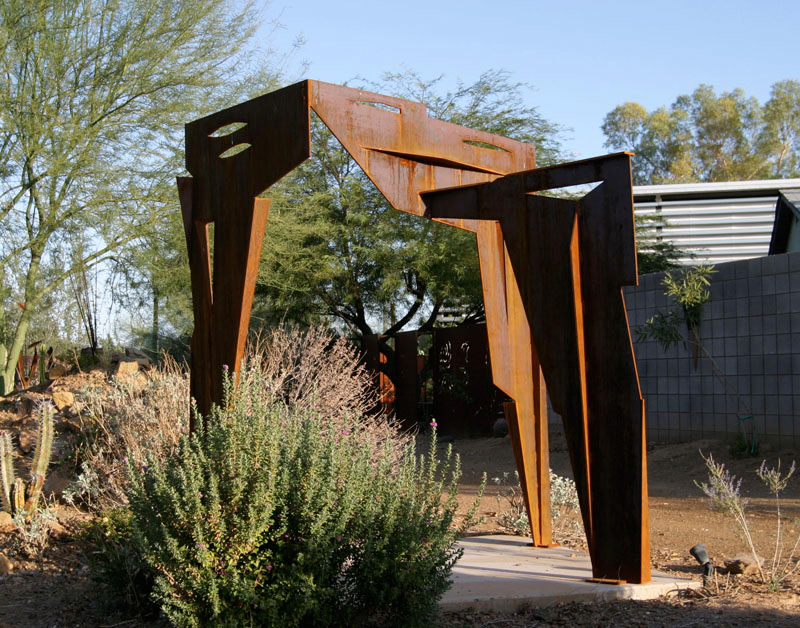
Artist statement
I design and make art everyday. Art is my life. I surround myself with it and am absorbed by it. My artistic style keeps evolving because of my fascination with new materials, differing environments and technology. I’m constantly looking for new mediums and ways to incorporate a wide variety of materials into my artworks.
About the artist
I have designed, built and installed 2d and 3d art projects for the past 30 years and have created large monumental works of art for Buildings,Hotels, Plazas and Cities. These include: commissioned sculptures
at an ecological museum in the south of France, sculptural color changing light fixtures commissioned for the W Hotel Scottesdale, Arizona, transit shelters for the city of Tempe and a hanging atrium sculpture for the city of Scottsdale. I have worked with a variety of collaborators including ; architects, artists, Engineers, Mayors of Cities and the Detroit Firemen installing a temporary sculpture on Hart Plaza, Detroit MI.
Selected Global and National Collections include: Nicosia, Cyprus; Puget Rostang, France; Phoenix, Scottsdale, Tempe, and Paradise Valley, Arizona; Hyatt Roissy Hotel, Paris France; Sremski Karlovci, Serbia.
For more information, visit www.jeffzischke.com.
Circa Cinq (of the Sacred Geometry Series)
Julia Stout
Black Mountain, North Carolina
Powdercoated then faux finished on 5 welded steel circles on milled bases that turn 360 degrees
5′, 4′ 2″, 3′ 4″, 2′ 6″
Part of the Downtown Boone Development Association (DBDA) Public Art Program
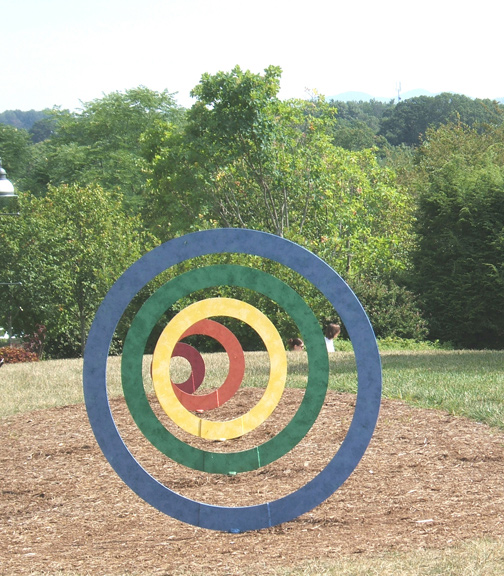
Artist statement
Art reflects my life experiences: the sum total of all that I am at that particular moment.
My development of the series of Sacred Geometry evolved as I have studied Yoga and the geometry of the elements. I began with the earth: cube is the geometry of salt and the most fundamental earth element;
the sacred geometry of water is the circle. whatever goes up must come down, nothing in life is permanent. I choose five circles to represent all five elements: earth, water, fire, air, and ether/void. The circles were designed to spin to show each vortex/chakra/element in our bodies can spin or get caught in stillness at any given time. The earth is our structural alignment or connection with self and others or not;
The water is our creativity, our passion, our sexuality, how we flow in life, or not.
The colors and the knowledge evolved from the studies of many of my yogic textbooks on each elemental vortex.
The rest (fire, air, ether) will come, as I continue to develop my series around the elements.
About the artist
My artistic inquiry for the past fifteen years has been in mixed media, metal, stone, and patinas. Currently I am working with three themes: Sacred Geometry, Awakened Consciousness (Stone Souls Rising), and Calling of the Elders. I have a Masters Degree in Product Design from NCSU, 800+ hours of training hours as a Yoga instructor, and have been meditating for 18 years.
My intention is to design and build contemplative art that embraces the subtle aspects of myself through simple natural forms that are positive, playful, organic, safe, peaceful, and inspiring for myself and the public. I continue to find growth, discipline, patience, peace, and integrity in all that I choose to do: my art is an opportunity for me to share my growth.
For more information, visit www.giuilia.com.
Declan’s Keystone
Kyle Van Lusk
Brevard, North Carolina
Steel
9′ x 4′ 6″ x 2′
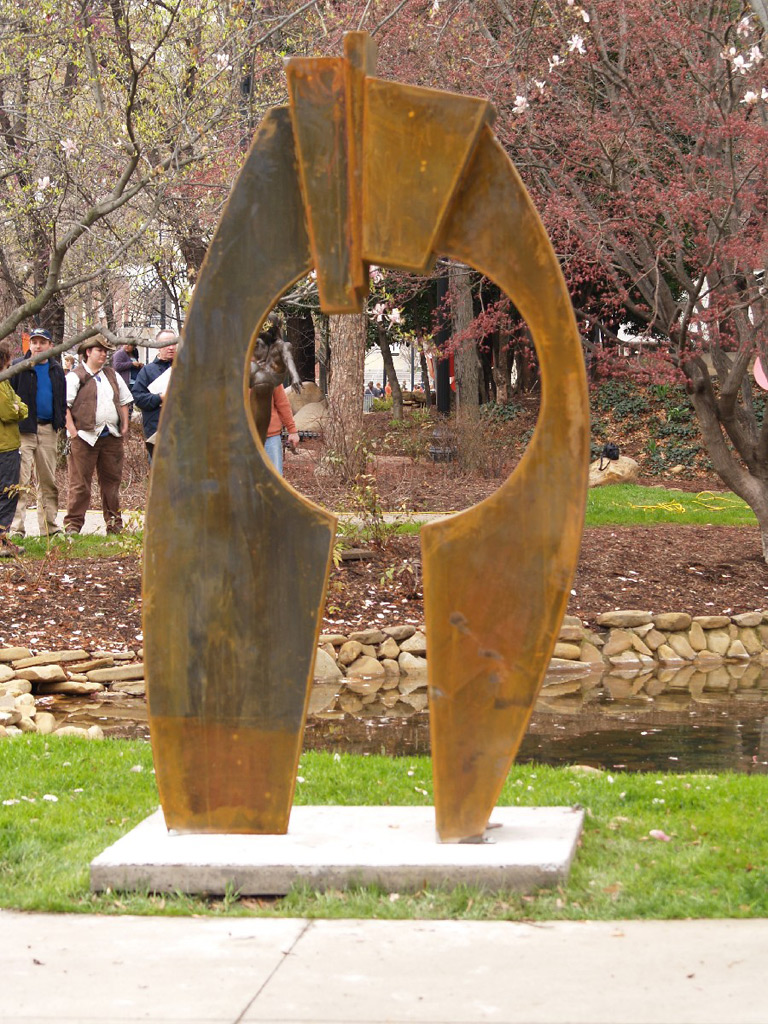
Artist statement
I strive to create work that is engaging and original. I primarily work non-objectively so my intension is not to directly represent an object or individual from life. I do, however, often use proportions and forms from the real world as inspiration. I believe that sculpture should be exciting and new to the viewer and yet still contain an element of familiarity. My hope is that upon experiencing my work the viewer has the feeling of being shown something they have never seen before yet still have a strong indefinable and compelling connection with.
About the artist
Kyle Van Lusk was born and raised in Brevard, N.C. and from a very young age was encouraged by his family to become an artist. Lusk received his first formal art training at Brevard College and later continued his undergraduate study at East Carolina University, earning his B.F.A. in 1995. Renowned for its excellent sculpture program, East Carolina University was also where Lusk chose to study as a graduate, earning his M.F.A. in 1998. Since completion of his graduate work in 1998, Lusk has created and exhibited work in galleries and public venues throughout the southeast. He served seven years on the Art faculty at Appalachian State University and is currently Associate Professor of Art at Brevard College in Brevard, N.C.
For more information, visit kylevanlusk.com.
Fresh Air Freshener (Bouquet & Fruit Punch)
Lee S. Millard
Bloomsburg, Pennsylvania
Latex paint on wood
6′ x 4′ x 9″
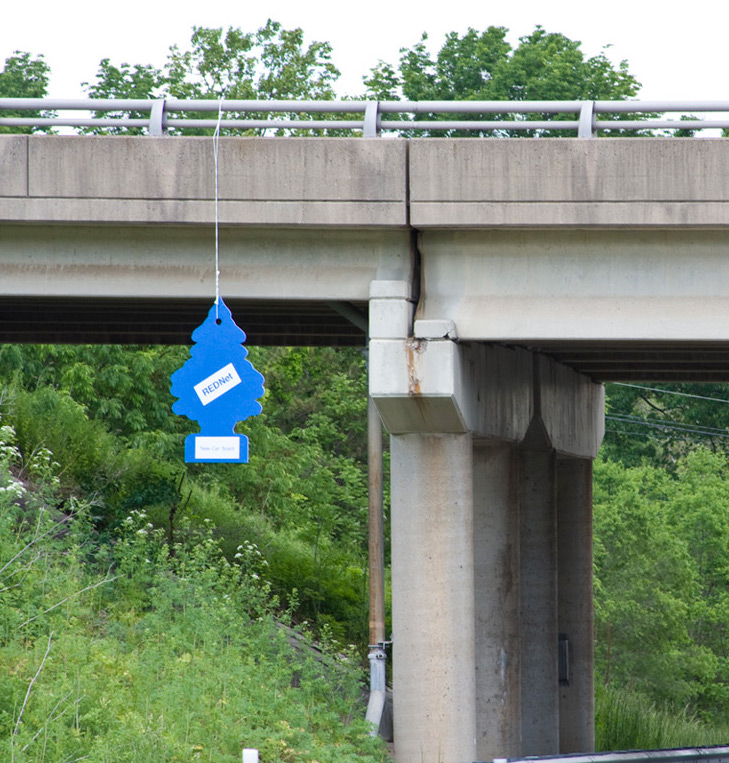
Artist statement
The idea to make six-foot tall air fresheners was initially a reaction to a 2006 Craig’s List post from a struggling, single mother who wrote that the only Christmas tree her family had was the one hanging from the rearview mirror of her car.
While the sentimentality of this mother’s statement may not be in the forefront of Fresh Air Fresheners anymore, the process of removing this well-known icon from its intended interior context to the outdoors and increasing the scale to the size of an actual Christmas tree takes on a more humorous and unusual life of its own. These colorful (not-so) little trees are placed in public places, usually without permission, to catch people off-guard, to make them laugh, and by using something familiar, make them re-think about their environment.
Fresh Air Fresheners have been known to show up hanging from train bridges, Santa’s Cottage, walking trails, and on college campuses.
About the artist
Bloomsburg, PA. He received his M.F.A. in Painting from The University of the Arts in Philadelphia and his B.A. in Studio Art from Bloomsburg University of Pennsylvania. He is currently the gallery associate for Haas Gallery of Art at Bloomsburg University and is an adjunct professor at Marywood and Misericordia Universities.
In 2006, Millard established his alias the Rural Experience Disruption Network (REDNet). Taking guidance from the Situationists, REDNet’s intention is to cause confusion, laughter and controversy by interrupting people’s everyday monotonous tasks by adding to and altering the rural environment around them.
Millard recently had a solo exhibition at Lock Haven University, PA, and was included in the group exhibitions Something About Nothing at the University of Ohio at Marion and Pennsyltucky: Are We There Yet? at Clarion University, PA. He has also shown his work in the following venues: Maryland Art Place, Baltimore, MD; Rosenwald-Wolf Gallery, Philadelphia, PA; Delaware Center for the Contemporary Arts, Wilmington, DE; Gwangju Museum of Art, Gwangju City, South Korea; Haas Gallery, Bloomsburg, PA; Mahady Gallery, Scranton, PA; and Ganser Gallery, Millersville, PA.
For more information, visit www.leesmillard.com.
Fuel for the Fire
Jim Buonaccorsi
Watkinsville, Georgia
Steel, cast iron, bronze, coal, electricity (lightbulb)
10′ x 5′ x 5′
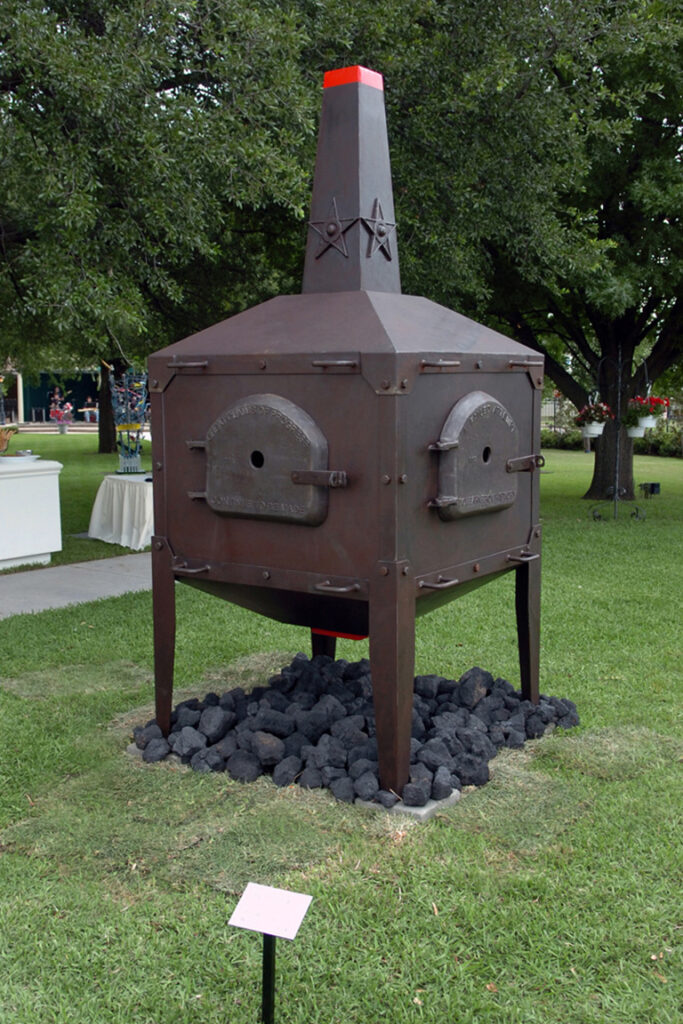
Artist statement
Fuel For the Fire, the work being presented in this years Rosen Outdoor Sculpture Competition and Exhibition, is probably best described by the text I chose to cast into the iron doors.
Great Claims Of Progress Continues To Be Made
A Failed Attempt To Learn From History
The Same Mistakes Are Being Made Efficiently
There Will Always Be Fuel For The Fire
As an artist I see my role at that of ‘scribe’. For me it is important that my work ask questions, addresses issues and acts as a social indicator of the time and place in this world in which we live. I am not so bold as to think my work can provide answers to the social, political, philosophical and theological issues it often addresses, nor is it an attempt at moralizing or passing judgment. This work is my way of confronting my own fears and misgivings of this life.
In presenting these concerns in a visual format, what I hope to accomplish as an artist is to awaken the often ‘turned blind eye’ of the viewer to also address these issues. Perhaps awareness of our inabilities would be at least half the battle towards making this a less complicated and volatile world.
Unfortunately it is apparent that the human race has a short and fleeting memory. What may be considered its greatest attribute, the power of reason, may also be its biggest curse, as we are the only species that knowingly and wantonly kill our own!
To quote Albert Camus, “Beginning to think is beginning to be undermined”.
About the artist
Born 1957, Providence, Rhode Island
B.A. Rhode Island College, 1982
M.F.A. Cranbrook Academy of Art, 1984
Associate Professor, University of Georgia, Athens, Georgia
Jim Buonaccorsi’s work has been included in over one hundred and fifty exhibitions, including solo exhibitions at City Gallery Chastain in Atlanta, Georgia, 621 Gallery in Tallahassee, Florida, Fugitive Art Center in Nashville, Tennessee and Marshall Arts in Memphis, Tennessee. His most recent solo exhibition was held at The Flood Fine Art Center in Asheville, North Carolina in 2008. His work has received numerous awards including the Reese Collection Annual Purchase Award at the University of Tennessee and The Martin and Doris Rosen Award at the Rosen Outdoor Sculpture Competition, Appalachian State University, Boone, North Carolina. He has also received a Georgia State Council for the Arts Individual Artist Grant and the M.G. Michael Award for outstanding research and two Senior Faculty research grant at the University of Georgia. His work is in numerous public and private collections. Jim and his wife, LeeAnn Mitchell, also a sculptor, live and run their studios in Farmington, Georgia.
For more information, visit www.metaletal.com.
Look Homeward Angles
Robert Winkler
Asheville, North Carolina
Cedar, steel, clear preservative
9′ x 10′ 10″ x 3′ 8″
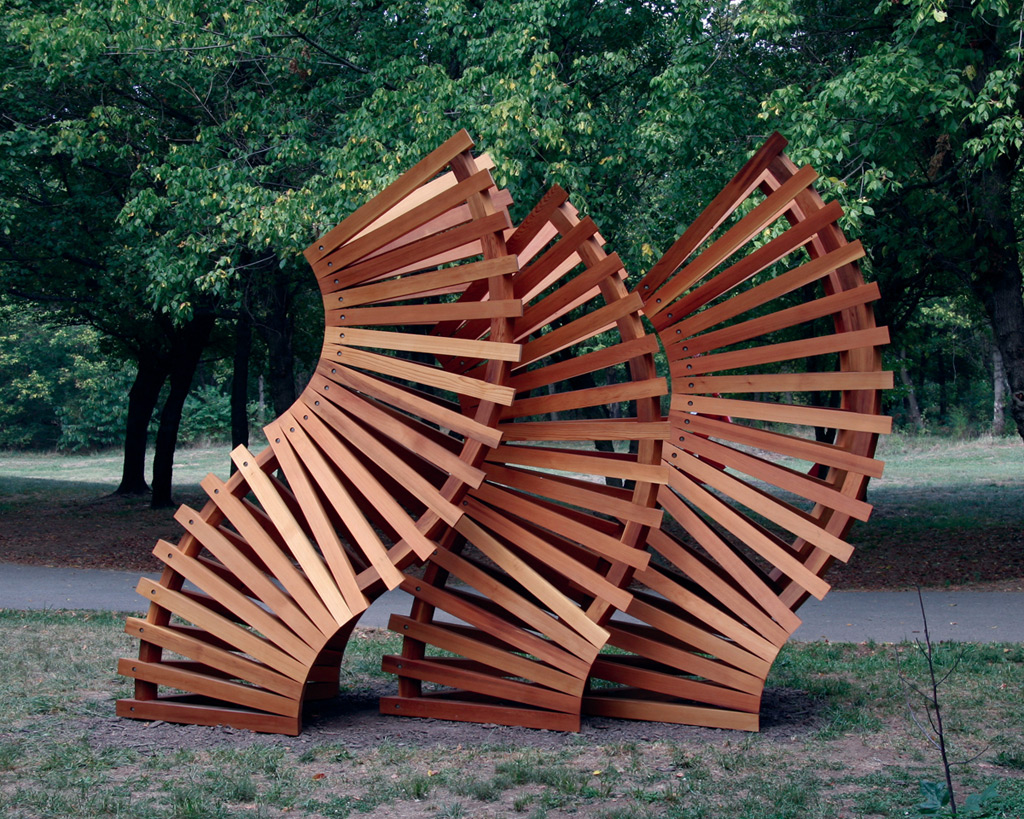
Artist statement
People often ask me what inspired one or another of my sculptures. But the more relevant question is, “What do my abstract forms inspire in the viewer?” Although my forms are abstractions of movement and balance, each viewer seems to reference some image or object from their own experience.
Since the early 90s, I have been manipulating volume, mass and balance to create a sense of movement. In some works, the graceful, gravity challenging forms seem to resist the downward pull of the Earth and reach heavenward, where others attempt to break away but are anchored to the earth.
My concern is with movement rather than material. Above all, it is my goal to find infinite variation within a limited number of forms. I have found that I can achieve serpentine, animated shapes through the use of incremental gradations, without so much as a single curved element. Because of the simplicity of the forms, it is a discipline that offers no hiding place for error, demanding meticulous workmanship.
About the artist
In 2003, when Robert Winkler moved his studio from Brooklyn, NY to Asheville, NC, collectors in both cities were curious to see if the softness of the mountains would be reflected in his new work. The first test arrived before the moving boxes were unpacked, when he was invited to participate in a project for that year’s Venice Biennale. His response was a continuation of the forms he had been exploring since the early ‘90s and continues to explore today. What defines his work is the ability to manipulate volume, mass and balance to create a sense of movement, achieving serpentine, animated forms without a single curved cut.
Born in 1947 in Cleveland, Ohio, he has been pursuing his art for most of his life. By the age of seven, he was attending the children’s art classes at the Cleveland Museum of Art. He went on to study ceramics, painting and sculpture at schools in various cities, including the Cleveland Institute of Art, Ohio State University and the School of Visual Arts in New York.
An internationally exhibited sculptor and the founder of Asheville’s RiverSculpture™, Robert is a passionate proponent of public art. His sculpture is collected by corporations, museums and private individuals.
For more information, visit www.robertwinklersculpture.com.
Phil Proctor is an artist who has been living and working in southeast Atlanta for the past five years. Originally from south Mississippi, he holds a BFA from the University of Southern Mississippi and an MFA from East Carolina University. Proctor has permanent sculpture installations throughout the southeast as well as in other countries across Western Europe. In 2003 Phil was commissioned by a private development group in conjunction with the City of Atlanta and Marta to design and construct a public artwork, Linkage, which now stands at the Lindbergh City Center Marta station. In 2008 Proctor received another commission from the city of Atlanta to design and build a 22′ tall kinetic sculpture for South Bend Park scheduled for installation in mid 2009.
For more information, visit www.philproctor.com.
Oriental
Guy Bellaver
St. Charles, Illinois
Painted steel (hand-made I-beams with concrete “dry garden” base)
12′ x 7′ x 4’8″
Part of the Downtown Boone Development Association (DBDA) Public Art Program
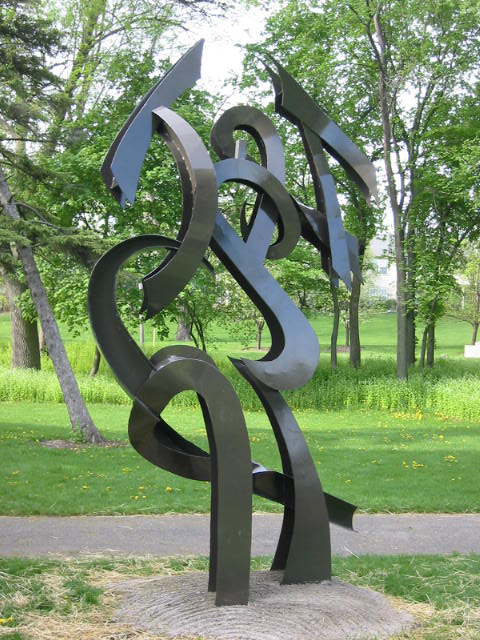
Artist statement
Oriental is inspired by the art of calligraphy. The brush strokes and their fluid movements are inherently beautiful – and this movement and flow, although only two dimensional, were the inspiration for creating the sculpture. The material used to convey the idea is steel. It is presented in an industrial shape called an I-beam. The I-beams used in this piece are hand-made, three-piece steel structures made up of a web with two sides welded perpendicular to the web. This steel configuration gives the sculpture structural strength while allowing the artist to shape it into the flowing sections of the sculpture.
The flowing sculpture emerges from a base made up of a sand and cement mixture (which mimics the Japanese art of “karesansui”.). The mixture is deposited at the base of the sculpture while in a pliable state and then raked by the artist. The impression made by the rakes’ teeth remains once the mixture hardens. These impressions give the finished sculpture and it’s siting a complete interpretation.
About “Karesansui”
In Japanese karesansui means dry landscape. Because of its features it looks much more like a painting than a garden. In fact, whereas the Western garden is conceived as an exploitable open space to walk in, grow plants, enjoy relaxing moments, the karesansui is a meditation garden.
You observe and admire it from outside its borders, usually only from one perspective, emptying your mind and at the same time gathering the feelings the arrangement conveys. While in a normal garden there are many distracting elements (plant varieties with different shapes and colors, falling leaves, windblown branches, animals…), before a karesansui you can reach peace because you’re surveying a complete stillness.
Karesansui gardens reproduce natural landscapes in a more abstract way by using stones, gravel, sand and sometimes a few patches of moss for representing mountains, islands, boats, seas and rivers. Karesansui gardens are strongly influenced by Zen Buddhism and used for meditation.
The aesthetic consonance with abstract art largely accounts for the resurgence of karesansui gardens both in Japan and abroad in the 20th century.
About the artist
Mr. Bellaver is a sculptor whose works span many mediums, including stone, wood, painted steel, and bronze. His monumental works include The Kane County Veterans Memorial, Geneva, IL; Ēkwabet (Potawatomi Indian – found in the Art Inventories Catalog of the Smithsonian American Art Museum), St. Charles, IL; The Crucifixion of Christ (both bronze and wood), St. Patrick’s Church, St. Charles, IL; The Growth of Post Modern, MCC Technology, St. Charles, IL; Limestone in the Wind/Pittsburgh, Latrobe, PA; and Jesus Christ/The Resurrection, The Daughters of St. Paul, Boston, MA.
Mr. Bellaver’s sculptures also appear in the corporate, university, and civic collections of the Forest County Potawatomi Cultural Museum, Crandon, WI, Armstrong County, Kittanning, PA, Elgin Community College, Elgin, IL, Forbes Health System, Pittsburgh, PA, Graphite Sales, Inc., Chagrin Falls, OH, H.J. Heinz Corporation’s International Headquarters, Pittsburgh, PA, Hiram College, Hiram, OH, Indiana University of Pennsylvania, Indiana, PA, Property Investment Company, Indianapolis, IN, and St. Vincent College, Latrobe, PA, among others. His work also appears in private collections around the country. Avera McKennan Hospital and the Washington Pavilion of Arts and Science in Sioux Falls, South Dakota are leasing his work, and he is also a finalist in a competition to create a monumental “icon sculpture” for Avera McKennan’s Hospital Campus. Mr. Bellaver is currently represented by Bridges – a Gallery of Fine Art (St. Charles, IL).
After his discharge from the United States Army, Mr. Bellaver earned a B.A. in Economics from St. Vincent College. He has been employed as a sales representative by Prudential Insurance and Xerox. He has worked as a sculptor full time since 1976. Mr. Bellaver has taken masters credit classes in art at Carnegie Mellon University, the University of Pittsburgh, and Northern Illinois University, as well as The School of the Museum of Art in Chicago. He is presently a member of the Dupage Art League and the Fox Valley Arts Council and sits on the Boards of the St. Charles Visitors and Cultural Commission and the St. Charles Rotary Club and Foundation. Mr. Bellaver is a past President of the St. Charles Rotary Club and a past Chairman of the Downtown St. Charles Partnership’s Public Art Committee.
Prism Arc ASU #1
Carl Billingsley
Ayden, North Carolina
Steel
4′ x 5′ x 12′
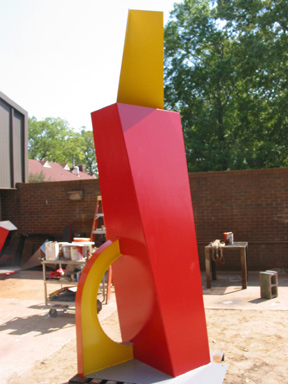
Artist statement
My most recent work has involved a renewed interest in and exploration of color. Having made numerous sculptures which were intended to maintain as direct a relationship to the process and material as possible and which were therefore not painted, I decided to change my focus from the material to the dynamic of color in the public realm. I strive to utilize color as phenomenon and to bring the attention of the public to the many ways that color changes as the light changes and as the environment around the sculpture affects both the form and the color of the sculpture. Color is not a static, passive element in these sculptures. Prism Arc I is constantly changing: yellow becomes orange under the influence of reflected red, orange become red, and red shifts through values and intensity as the sun tracks through the sky.
About the artist
Carl Billingsley was born in Oklahoma and spent his formative years in a variety of locations as his father, a sergeant in the field artillery, was transferred from post to post. Three years in Germany made an indelible impression on Billingsley and he has returned to Europe as an adult many times. Billingsley teaches sculpture at the School of Art & Design, East Carolina University and has a very active exhibition schedule. Billingsley’s work can be found in collections and sculpture parks from North Carolina to Wisconsin. He has permanent public sculptures in Norway, Israel, Estonia, Japan, China and Brazil.
For more information, visit www.billingsleyatelier.com.
Relic
Dana Gingras
Mooresville, North Carolina
Acid etched steel
7′ 6″ x 7′ 6″ x 4′
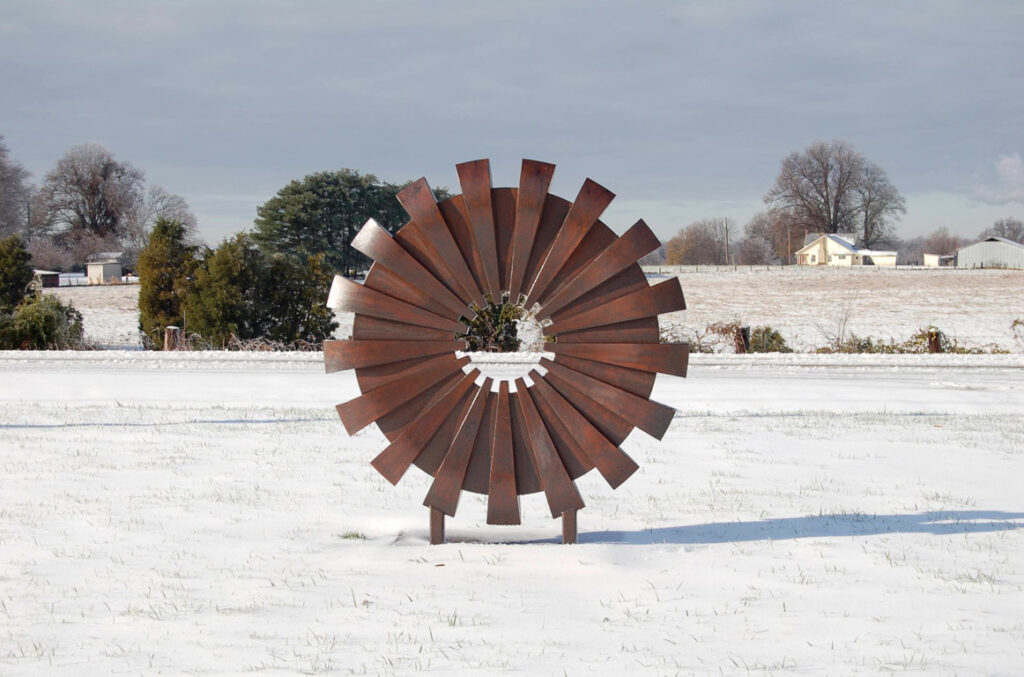
Artist statement
Growing up in rural northwest Connecticut, I was fascinated by all things old. Walking deep in the woods I would come across crumbled stonewalls, rusty pieces of metal, and countless odds and ends of different sorts. I would realize 200 years ago a farm might have stood there, or possibly an abandoned settlement. I spent countless hours digging and discovering trying to unearth treasures from the past, and figure out there use.
“Relic” is born from the memories of this simpler time. Its design comes from a melding of two series. The Window series that urges the viewer to see the mass of the sculpture, but at the same time to view the negative spaces and focus on the elements in nature which it frames, and the Building Block series which combines simplistic forms with complex constructions. “Relic” consist of one hundred and eighty individually cut, formed, and welded pieces of steel to create one unified mass. It was created to invite a feelings of mystery and wonder, but also to invoke questions such as; what is it? Where did it come from, and how was it used? “ Relic” is a testament to the past.
About the artist
Dana Gingras grew up surrounded by nature in rural Northwest Connecticut, the foothills of the Berkshire Mountains. After traveling extensively throughout Europe and the United States he received his degree from The University of Connecticut. Continuing his education he won a coveted apprenticeship at Lorenz Studios and spent the next three years refining his skills working with noted glass and steel sculptor Larry Livolsi. For the past fifteen years he has maintained a studio focusing on large-scale sculpture and custom interior pieces. Currently based in Mooresville NC. His work can be found in public and private collections across the country.
His primary mediums are glass, steel, and wood. Dana’s work comes from the process of understanding these materials, their intrinsic properties, and inherent beauty. “My goal is to create something new and visually stimulating, yet still retain the natural dignity of material”. He currently runs Gingras Studios in Mooresville, NC.
For more information, visit www.danagingras.com.
Roll Over
Robert Winkler
Asheville, North Carolina
Cedar, steel, clear preservative
5′ x 8′ 10″ x 7′
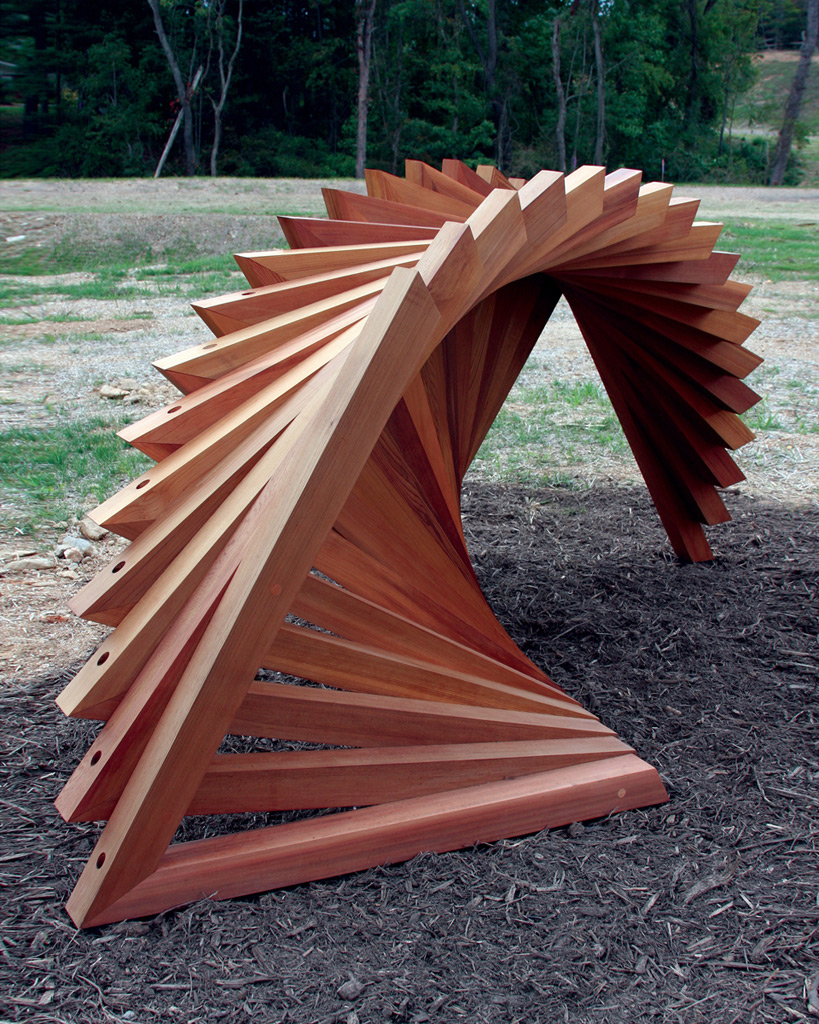
Artist statement
People often ask me what inspired one or another of my sculptures. But the more relevant question is, “What do my abstract forms inspire in the viewer?” Although my forms are abstractions of movement and balance, each viewer seems to reference some image or object from their own experience.
Since the early 90s, I have been manipulating volume, mass and balance to create a sense of movement. In some works, the graceful, gravity challenging forms seem to resist the downward pull of the Earth and reach heavenward, where others attempt to break away but are anchored to the earth.
My concern is with movement rather than material. Above all, it is my goal to find infinite variation within a limited number of forms. I have found that I can achieve serpentine, animated shapes through the use of incremental gradations, without so much as a single curved element. Because of the simplicity of the forms, it is a discipline that offers no hiding place for error, demanding meticulous workmanship.
About the artist
In 2003, when Robert Winkler moved his studio from Brooklyn, NY to Asheville, NC, collectors in both cities were curious to see if the softness of the mountains would be reflected in his new work. The first test arrived before the moving boxes were unpacked, when he was invited to participate in a project for that year’s Venice Biennale. His response was a continuation of the forms he had been exploring since the early ‘90s and continues to explore today. What defines his work is the ability to manipulate volume, mass and balance to create a sense of movement, achieving serpentine, animated forms without a single curved cut.
Born in 1947 in Cleveland, Ohio, he has been pursuing his art for most of his life. By the age of seven, he was attending the children’s art classes at the Cleveland Museum of Art. He went on to study ceramics, painting and sculpture at schools in various cities, including the Cleveland Institute of Art, Ohio State University and the School of Visual Arts in New York.
An internationally exhibited sculptor and the founder of Asheville’s RiverSculpture™, Robert is a passionate proponent of public art. His sculpture is collected by corporations, museums and private individuals.
For more information, visit www.robertwinklersculpture.com.
Phil Proctor is an artist who has been living and working in southeast Atlanta for the past five years. Originally from south Mississippi, he holds a BFA from the University of Southern Mississippi and an MFA from East Carolina University. Proctor has permanent sculpture installations throughout the southeast as well as in other countries across Western Europe. In 2003 Phil was commissioned by a private development group in conjunction with the City of Atlanta and Marta to design and construct a public artwork, Linkage, which now stands at the Lindbergh City Center Marta station. In 2008 Proctor received another commission from the city of Atlanta to design and build a 22′ tall kinetic sculpture for South Bend Park scheduled for installation in mid 2009.
For more information, visit www.philproctor.com.
About the juror
Jerry Jackson has served as the deputy director for Penland School of Crafts in Penland, NC since July 2007. Prior to his tenure at Penland, Jerry was the chief curator and director of the Rocky Mount Arts Center at the Imperial Centre for Arts and Sciences, Rocky Mount, NC. He brings extensive expertise in exhibition, collection and archive practices to the position. Historical preservation was also a key component of his previous experience. The Imperial Centre development was a 6-year rehabilitation project that included a complex of historical structures that ultimately became a 145,000sf facility. Jackson currently serves on the boards of the Mitchell County United Way and the Mitchell County Chamber of Commerce. Past board appointments include Pocosin Arts, the North Carolina Museum Council, Eastern North Carolina Visual Arts Consortium, Very Special Arts and the Professional Arts Councils of Eastern North Carolina. Jerry received his MFA and BFA from East Carolina University in studio art.
Jackson holds M.F.A. (2006) and B.F.A (1983) degrees in ceramics from East Carolina University, and A.A. (1980) degree from Wingate University. He has spent the majority of his arts career as a curator and arts administrator. Jerry has been in the position of Deputy Director at Penland School of Crafts since July 2007. Prior to relocating to Penland, he served 11 years as curator and cultural arts administrator (director) at the Rocky Mount Arts Center.
Jackson has curated dozens for exhibitions during the past 12 years and has served as juror for numerous exhibitions throughout the southeast. He has served on the board of Pocosin Arts, the North Carolina Museum Council, Eastern North Carolina Visual Arts Consortium, Very Special Arts and the Professional Arts Councils of Eastern North Carolina. In 2007, he was awarded the Mid-Career Arts Administrator Award from the North Carolina Museum Council. Currently, he serves as the Travel and Tourism Chair for the Mitchell County Chamber of Commerce and is a board member for Mitchell County United Way.
About the curators
Hank Foreman
Hank Foreman serves as Assistant Vice Chancellor of Arts and Cultural Affairs as well as Director and Chief Curator of the Turchin Center for the Visual Arts for Appalachian State University. He obtained his M.A. in Art Education from Appalachian, having completed undergraduate studies at the University of North Carolina at Charlotte, with a concentration in Painting and Sculpture. His duties include the administrative responsibilities for An Appalachian Summer Festival, the Performing Arts Series, Farthing Auditorium and the Turchin Center for the Visual Arts.
During his tenure at Appalachian State, Foreman has taken part in the organization of numerous exhibitions, including the associated lectures, symposia, and publications. He has worked closely with the university’s Department of Art, and a wide variety of other campus and community groups, to make gallery resources available to all. One of his earliest exhibitions at Appalachian, Views From Ground Level: Art and Ecology in the Late Nineties, brought internationally acclaimed artists, historians, and critics to the campus and received national attention.
Foreman is also an exhibiting studio artist, and participates in regional and national conferences as a presenter and panelist.
Brook Bower
Brook Bower serves as the assistant curator and administrator for the Turchin Center for the Visual Arts and its staff. She received a BS in Art Management and a BFA in Ceramics from Appalachian State University’s Department of Art in 2001. Bower’s professional activities include curating exhibitions, lecturing, consulting for competition management, serving as a juror for local competitions, mentoring future art management students and managing several national art competitions including the Rosen Sculpture Competition, the Halpert Biennial and the Appalachian Mountain Photography Competition. Bower also serves as the Acting Registrar, providing collections management support for the Turchin Center’s Permanent Collection containing 1,481+ objects and managing the Intra-Campus Loan Program.
Following her undergraduate degrees, she has concentrated on furthering her education by attending conferences, courses and workshops expanding her knowledge of curatorship, exhibition design, and collections management. Bower recently participated in the 2011 SEMC Jekyll Island Management Institute and is currently seeking a Master of Visual Arts Administration, with a focus in curatorial studies, at New York University in New York City. She serves on multiple committees that concentrate on community enhancement utilizing the visual arts and serves as the faculty advisor for the Arts Management Organization (AMO). In addition, Bower is an active exhibiting artist.
